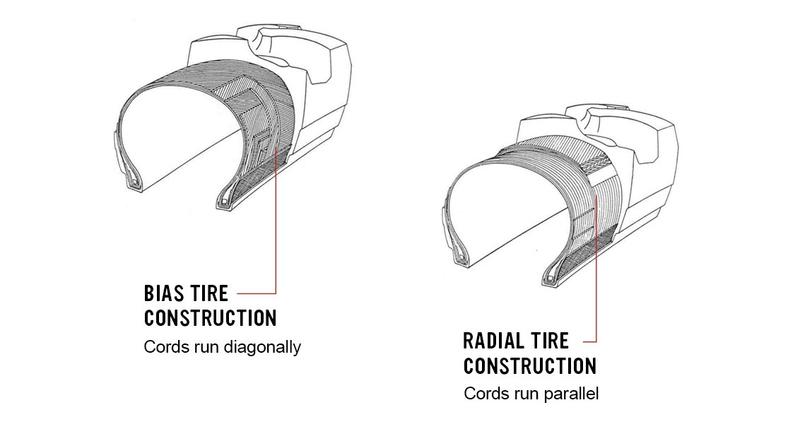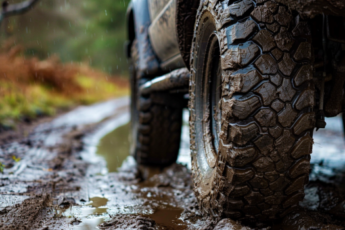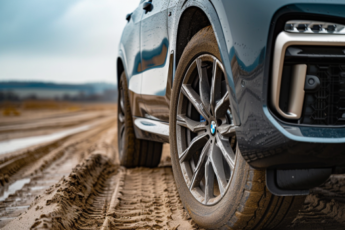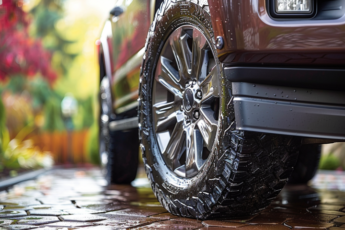Last Updated on 2 weeks
Exploring the Pros and Cons of Radial Tires and Bias Ply Tires
Regarding tires, two primary types are being compared: radial tire vs bias ply. Both have their benefits and drawbacks, so it’s essential to understand their differences before purchasing. This guide will help you do just that.
This article will examine radial and bias ply tires to understand their advantages and disadvantages. We’ll simplify the differences between these two tire types so you can make an informed decision when choosing the right tires for your vehicle. Let’s dive into the world of tires and explore the pros and cons!
Radial Tires vs Bias Ply Tires – Explained
Image 1: Plies in Bias Tire Construction vs Radial Tire Construction (Source: Teamtractor.com)

What is a radial tire?
The radial tire was invented in 1948 by the Michelin Tire Company. This type of tire is often referred to as a “radial” since it resembles the spokes of a wheel. A radial tire features multiple layers of reinforcing cords that run parallel to each other rather than crossing over, like those in traditional pneumatic tires. These cord angles allow the tire to withstand greater forces without breaking down.
In addition to being more robust, the radial tire offers improved handling characteristics compared to bias-ply tires. They’re better able to take lateral force, meaning they won’t roll off the side of the vehicle. Radials also provide superior traction and stability because of their unique design.
About the plies of radial tires: A radial tire is designed so that the plies don’t extend across and down the entire wheel. Instead, its plies comprise individual layers that allow them to flex independently from one another.
What is a bias ply tire?
The earliest automotive tires, pneumatic tires, were all bias-ply tires. They had no internal air chambers. Instead, they relied on the pressure within the rubber itself to keep the tire inflated. You’ll find that the plies are laid out in a layered, angled crisscross pattern. These early pneumatic tires were all bias-ply tires.
About the plies of bias ply tires: In a bias ply tire, you’ll find that the plies are laid out in a layered, 45-degree angle, crisscross pattern. Each ply starts at one side of the tire, heads up the sidewalls, crosses over the crown area, and finishes down the opposite side. This process occurs throughout the tire’s width, resulting in a rigid structure.
Choosing A RADIAL Tire: Advantages and Drawbacks
Radial Tire Advantages
- A significantly increased tread life
- Dissipates heat more efficiently, reducing heat buildup in tires
- Features a broader footprint, which results in improved traction
- It offers a smoother ride and high-speed stability
- Resists punctures and sidewall damage (for reinforced sidewalls)
- Better handling during cornering and manoeuvring
Drawbacks of Radial Tires
- Radial tires are more expensive than bias-ply tires due to the complexity involved in manufacturing them.
- Limited availability of much bigger tire sizes
Choosing A BIAS PLY Tire: Advantages and Drawbacks
Bias Ply Advantages
- Generally less expensive
- Better in terms of load-carrying capacity
- Crosshatch construction provides more rigid and puncture-resistant sidewalls.
- Great for off-road applications in which sidewall flex is needed
- Naturally designed to be more robust and puncture-resistant on its sidewalls
- Availability of much bigger sizes
- Usual applications in agricultural and slow-speed setting
Bias Ply Drawbacks
- The biggest drawback is their shorter life span.
- It doesn’t perform as well as radials in high-speed setting
- A small footprint causes increased compaction and sinking in the field.
- Higher fuel consumption as a result of falling deeper into the area and developing ruts
Exploring the Pros and Cons of The Radial Tire And Bias Ply Tires
key points:
- Construction Differences: Explain how the radial and bias ply tires are constructed differently, with radial tires having cords laid at 90-degree angles and bias ply tires having cables at overlapping curves.
- Ride Comfort: Discuss how the radial tire offers a smoother and more comfortable ride due to its flexible construction.
- Traction and Handling: Highlight that the radial tires often provide better traction and handling on paved roads, making them suitable for most passenger vehicles.
- Load-Bearing Capacity: Explain that bias ply tires are known for their sturdiness and higher load-carrying capacity, making them ideal for heavy-duty and off-road applications.
- Fuel Efficiency: Mention that the radial tire tends to be more fuel-efficient due to reduced rolling resistance.
- Durability: Discuss the durability of bias ply tires in challenging conditions and their resistance to damage.
- Cost: Compare the cost differences between radial and bias ply tires, considering factors like initial purchase price and long-term value.
- Vehicle Compatibility: Explain which vehicles are better suited for the radial and bias ply tires.
- Noise Levels: Discuss whether one type of tire is quieter than the other during driving.
- Environmental Impact: Mention any ecological considerations, such as the materials used in each type of tire and their impact on sustainability.
These points will help provide a comprehensive overview of the pros and cons of the radial tires and bias ply tires in your article.
Radial Tires Excel Over Bias Ply Tires on most of the following aspects
Radial Wins
- Overall Grip and Traction
- Better Handling and Overall Flexibility
- Fuel Economy
- Heat Tolerance: Resistance to Heat Buildup
- Ride Quality: Smooth and Comfortable Ride
- Longer lasting
- Soil Compaction
Bias Ply Wins
- Rougher Surfaces and Low Speeds
- Puncture and Cut Resistance on Sidewalls
- Ease of Repair
- Availability of Much Bigger Tire Sizes
- Price
The radial tires are popular today because they offer superior traction and handling characteristics compared to bias ply tires. Its construction allows for better resistance to heat buildup and cuts. In addition, radials provide exceptional ride quality.
Bias ply tires still have their place in the industry, though – and for specialized applications, they can outperform radial tires, such as in rougher terrains, having more robust sidewalls, repairability, enormous size availability, and in terms of initial price investment (much lower).
So, how do I decide between radial tires and bias ply?
It’s best practice to have a checklist that you can use to help you make that decision. You need to thoroughly understand the tires’ applications, the type of driving, weather conditions, and terrain for your situation. Here’s what you should keep in mind:
- Buy tires based on how much money you want to save over the tire’s lifetime. Remember that the tire life cycle costs include tire replacement, maintenance, and repair costs.
- Don’t just look at the initial cost; consider other factors like tread wear, safety ratings, etc., and always keep your options open.
- Keep track of your tire usage and mileage to see if there are any trends.
- A good rule of thumb is that you spend too much money if you buy a new tire yearly.
In addition, most people only realize how critical load capacity is once they’re faced with a situation where they need to replace a tire: when choosing between two different brands, you want to select the brand with the load capacity that fits your case.
Conclusion
A radial tire offers a much more flexible sidewall structure to reduce rolling resistance than a bias ply tire. With less rolling resistance, the radial tires maintain their ideal shape, which helps minimize tire pressure on the pavement or terrain. This reduces overheating in the tread area to help you save on fuel and enhance the tread lifespan.
However, radial tires have their limitations – when damaged, it is recommended that only the tire’s tread centre be repaired since adding patches on the tire’s sidewalls and shoulder ribs compromises safety and will increase the risk of tire damage. It is best to approach your local tire shop for proper instructions.
Therefore, your choice eventually boils down to what’s suitable for your specific case, the particular application and use of the tires, and your short-term and long-term goals.
Ready to upgrade your tires?
Explore Giga Tires’ wide range of radial and bias ply options now. Get the right tires for your vehicle and conquer the road with confidence. Visit Giga Tires today!
You can check our bias ply and radial tires inventory on our online tire shop. The choice between them depends on your vehicle type and usage. To find the perfect tires for your needs, head to Giga Tires’ extensive selection and make a confident purchase today!
Want to learn even more about tires and maintenance? Visit Giga Tires’ website and explore our collection of informative articles.
- Unlocking Winter Excellence: The Ultimate Three-Peak Mountain Snowflake Guide For Superior Performance
- Tire Up For Winter With Mastercraft Tires – American-Made Quality At Affordable Prices
- High-Performance Tires: Discover The Top 7 Affordable & Popular Options
FAQs
What are radial and bias ply tires?
Radial tires and bias ply tires are two different types of tire construction. Radial tires are built with layers of cord plies laid at 90-degree angles to the travel direction, making them flexible and providing better traction and fuel efficiency. Bias-ply tires, on the other hand, have cord plies laid at overlapping angles, typically at 30 to 45 degrees. This construction offers sturdiness and is often used for heavy-duty applications.
Which is better, bias ply or radial?
The choice between bias ply and radial tires depends on your specific needs. Radial tires are generally better for most modern vehicles as they offer improved fuel efficiency, handling, and a smoother ride. Bias ply tires are preferred in heavy-duty and off-road situations because of their robustness and load-carrying capacity. So, it’s not about one being better than the other, but rather which is better suited for your vehicle and intended use.
Do radial tires have ply?
The radial tire has a ply, but its layers are constructed differently than bias ply tires. The radial tire has cord plies that run radially across the tire, providing flexibility and stability. This radial construction is why they are called “radial” tires.
What is a radial ply tire?
A radial ply tire has its cord plies laid in a radial or 90-degree pattern from the centre of the tire to the outer edges. This radial construction allows the tire to flex more, resulting in better traction and fuel efficiency. Radial ply tires are commonly used in passenger cars and modern vehicles for their superior performance on the road.










